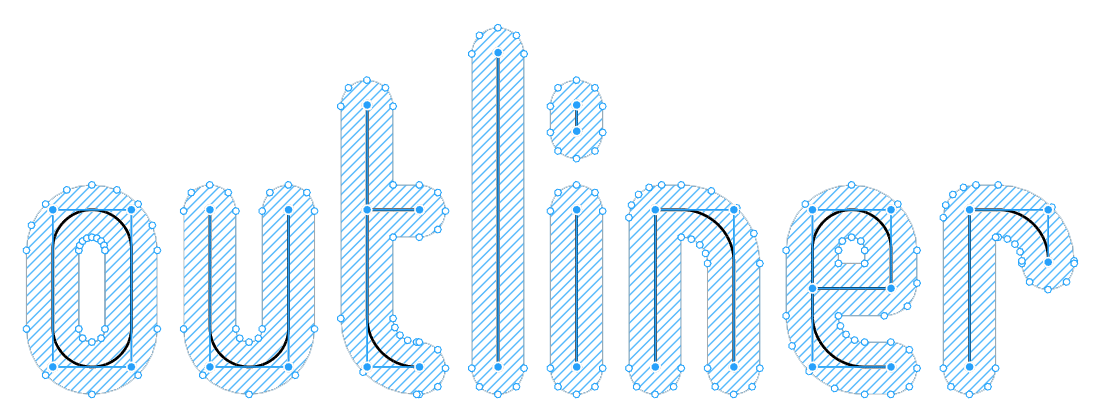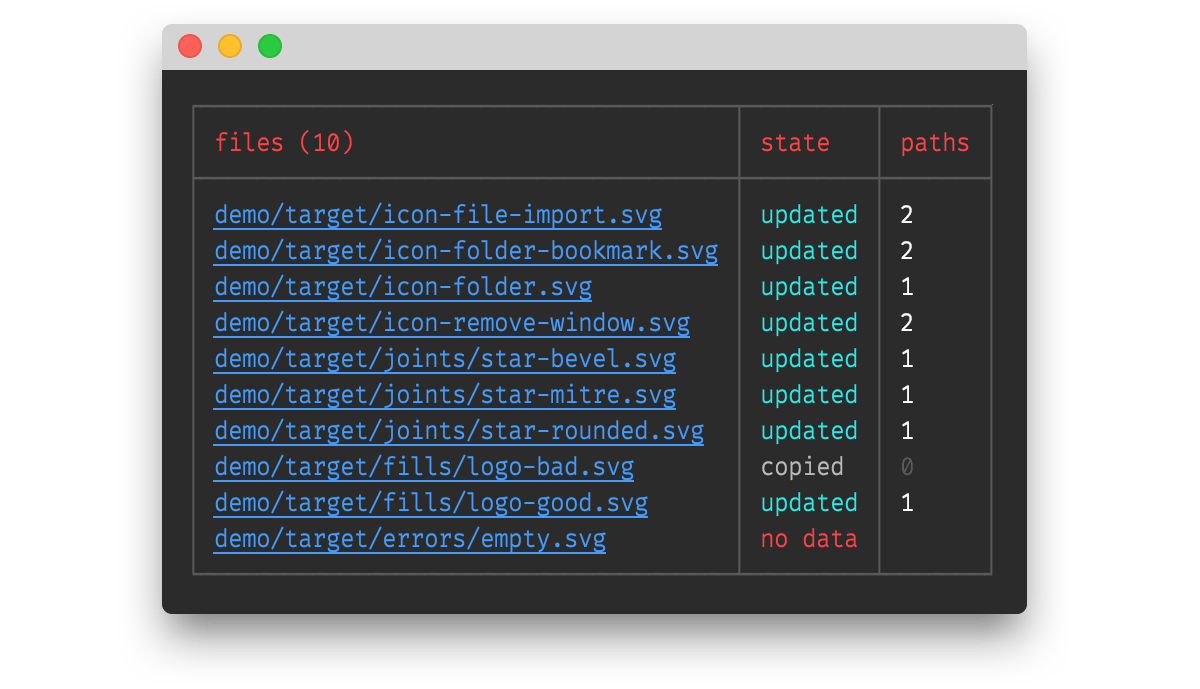https://github.com/davestewart/outliner
A node package to outline SVG strokes as fills
https://github.com/davestewart/outliner
design figma icons sketch sketch-plugin svg
Last synced: about 1 month ago
JSON representation
A node package to outline SVG strokes as fills
- Host: GitHub
- URL: https://github.com/davestewart/outliner
- Owner: davestewart
- Created: 2021-09-15T12:58:05.000Z (over 3 years ago)
- Default Branch: main
- Last Pushed: 2023-07-28T14:56:32.000Z (almost 2 years ago)
- Last Synced: 2025-04-10T09:12:53.450Z (about 1 month ago)
- Topics: design, figma, icons, sketch, sketch-plugin, svg
- Language: JavaScript
- Homepage:
- Size: 451 KB
- Stars: 38
- Watchers: 4
- Forks: 2
- Open Issues: 11
-
Metadata Files:
- Readme: README.md
Awesome Lists containing this project
README
# Outliner

## Intro
### Overview
Outliner is a Node package that converts SVG strokes to outlined fills as a *post-export* process:

Outliner is designed for:
- icon creators; no more locking in those curves and losing your vector tweaks!
- developers; work with clean SVG conversions and manipulate attributes in code
### Why outline strokes?
HTML + SVG + CSS is perfect for things like icons, however SVG + CSS may not always provide the intended result as you can see from this [comparison](./demo/comparison.html):

If your aim is to make colorising your icons predictable, then there are two main options:
- replace SVG colours with the CSS `currentColor` variable
- outline strokes
Using `currentColor` is an easy win, but you lose the icon's original color information (so not good for two-color icons). Outlining strokes is a more flexible, reliable, production-ready option.
The choice is up to you of course!
### Why the "post-export" process?
Processing your SVGs files after they have been exported enables you to keep strokes and retain flexibility within [Figma](https://twitter.com/figmadesign) or [Sketch](https://twitter.com/sketch):
- strokes allow you to adjust widths and corner radii on the fly
- outlined objects cannot be changed once outlined
- union operators close open paths (Sketch) or create heavy exports (Figma)
### Are there any drawbacks?
There are a few things to consider:
1. stroke conversion does not always work first time; you may need to tweak your original vectors; adjusting layer order or redrawing some simple shapes can work. Note that it seems to rarely happen on simple shapes, and there is [a ticket open](https://github.com/davestewart/outliner/issues/1) to look at this again.
2. some join caps [don't seem to properly convert](https://github.com/davestewart/outliner/blob/main/src/tasks/outline.js#L34), so the package currently forces round caps.
3. if you want to be sure the graphic you see in your drawing package is the same as the one that is saved to disk, you may want to stick to outlining in your drawing package (though be aware, exported outlines from your package of choice [may be heavier than you expected](https://twitter.com/dave_stewart/status/1437980506205958148)).
## Getting started
To use Outliner, you will need [Node](https://nodejs.org/en/) and NPM installed.
Once installed, there are two ways to use Outliner:
- as a **[service](#running-as-a-service)**, where you watch a source folder and convert files as you export them
- as a **[dependency](#running-as-a-dependency)**, where you use the conversion functions Outliner exposes in your own project
If you want to run Outliner from anywhere on your machine, install **globally** and run as a **service**.
## Running as a service
### As a global service
> Best for designers working alone
Open a terminal prompt and install the package globally:
```bash
npm install @davestewart/outliner --global
```
To start converting, call the `outliner` service passing `source` and (optional) `target` paths:
```
node outliner
```
Note:
- paths can be relative or absolute
- if you omit `target`, your `source` files will overwritten in place
- To remove `width` and `height` information (so they resize nicely) pass the `--autosize` flag:
```
node outliner --autosize
```
### As a project service
> Best for designers working in teams
You can also run Outliner as a service **within** a JavaScript project.
This makes it simple for *anyone* who is working with the project source to update assets.
This time, install Outliner *locally*:
```bash
npm install @davestewart/outliner --save-dev
```
Then, add a script entry to your project's `package.json`, e.g.:
```json
{
"scripts": {
"outline-icons": "node outliner --autosize"
}
}
```
You can then run the Outliner service like so:
```bash
npm run outline-icons
```
Outliner will start and watch the folder you specify in `` and output to ``.
### Logging
Once the service is running, Outliner will start converting files and logging results:

The service will continue to watch the `source` folder, and any further exports will be detected, converted and logged automatically.
A good terminal should render the paths as clickable links, making it easy to open the updated files.
For reference, the log states are:
| State | Description |
| --------- | ------------------------------------------------------------ |
| no file | the source file did not exist |
| no data | the source file contained no data |
| no write | no target file was written, only the output returned (API only) |
| no change | no change between output and target, so the target was not updated |
| updated | the new output was different from the old, so the target was updated |
| copied | the source file did not exist in the target folder, so was copied |
## Running as a dependency
> Best for developers who need to manipulate SVGs
Outliner is a typical dependency that you install and use like any other package.
Install as usual:
```bash
npm i @davestewart/outliner --save-dev
```
There are two functions exposed:
- `outlineFile()` - loads a file, outlines it, and returns or saves the result
- `outlineSvg()` - outlines SVG text only
Converting files should be straightforward:
```js
// import dependencies
import { outlineFile, outlineSvg } from '@davestewart/outliner'
// convert a file and save a copy
outlineFile('./assets/src/star.svg', './assets/trg/star.svg')
// convert a file and save in place
outlineFile('./assets/src/star.svg')
// get the converted output but don't save
const output = outlineFile('./assets/src/star.svg', false)
// convert existing SVG text
const output = outlineSvg(input)
```
Note that you can also pass a couple of extra arguments to:
- change how Outliner behaves
- log task information
For example:
```js
// variables
const tasks = ['outline'] // outline but don't strip width and height
const log = {} // object to collect logging info
// convert
outlineFile('./assets/src/star.svg', './assets/trg/star.svg', tasks, log)
// debug
console.log(log)
```
The log object will be populated by each of the tasks that ran:
```
{
paths: 1,
autosize: true,
state: 'updated'
}
```
Note that you can also pass custom functions as `tasks`:
```js
function replaceColor (svg, log) {
log.replaceColor = true
return svg.replace(/#000000/g, 'currentColor')
}
outlineSvg(svg, ['outline', replaceColor], log)
```
Check the `tests/index.js` file for working code.
## API
#### Outline File
> Outlines a source file and overwrites or writes the results to a new file
Signature:
```ts
outlineFile(src: string, trg?: string | false | null, tasks?: Array, log?: object)
```
Parameters:
- `src`: a relative or absolute path to a source folder
- `trg`: an optional relative or absolute path to a target folder
- pass `undefined` to use the same `src`
- Pass `false` or `null` to skip writing and just return the output
- `tasks`: an array of tasks to run, defaults to `['outline', 'autosize']`
- string tasks should be one of `'outline'` or`'autosize'`
- functions should be of the format `(svg: string, log: object) => {}: string`
- `log`: an optional `{}` object to receive logging information
#### Outline SVG
> Outlines SVG text and returns the result
Signature:
```js
outlineSvg(svg: string, tasks?: Array, log?: object)
```
Parameters:
- `svg`: valid SVG text
- `tasks`: an array of tasks to run, defaults to `['outline', 'autosize']`
- string tasks should be one of `'outline'` or`'autosize'`
- functions should be of the format `(svg: string, log: object) => {}: string`
- `log`: an optional `{}` object to receive logging information
#### State
> An object of constants to compare against
The `log.state` for each file operation will contain one of these values:
```js
State.NO_FILE = 'no file'
State.NO_DATA = 'no data'
State.NO_WRITE = 'no write'
State.NO_CHANGE = 'no change'
State.UPDATED = 'updated'
State.COPIED = 'copied'
```
## Demos
> If you clone the repo, you will be able to play with the demo.
Run the demo with:
```
npm run demo
```
You can compare the `source` and `target` output in Figma, Sketch, or a text editor.
If you want to tweak and re-export the source files, Outliner will pick up any changes and update the target folder each time you export.